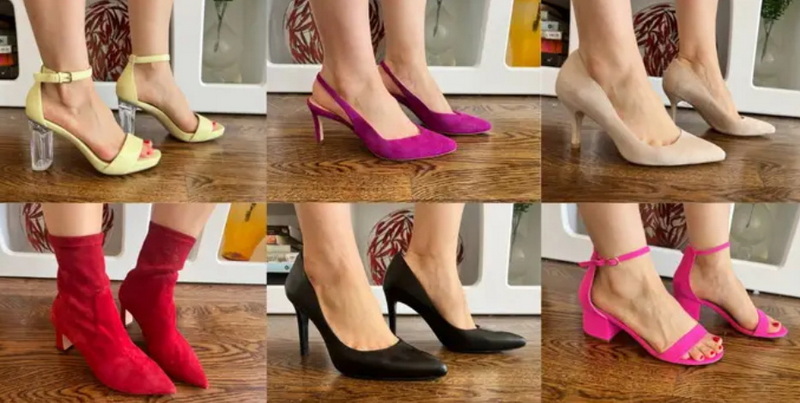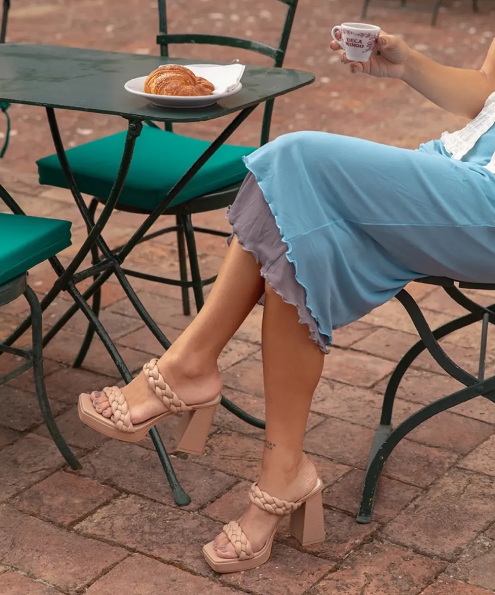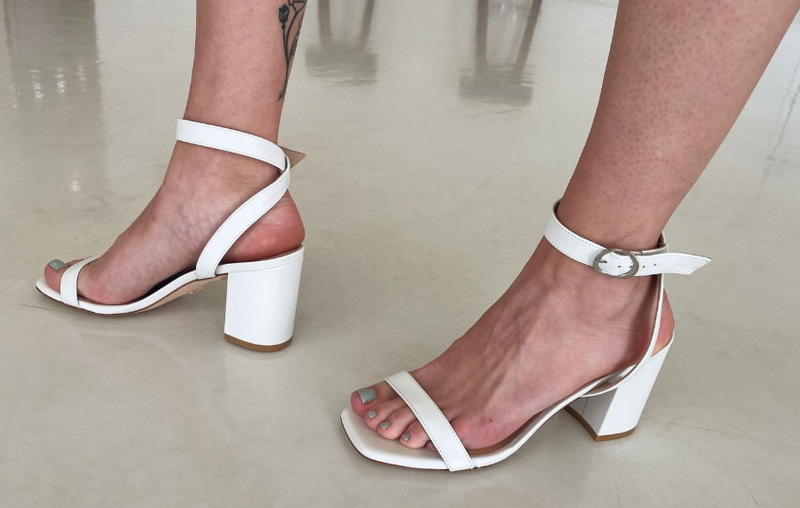Content Menu
● The Historical Context of High Heels
● Health Concerns
● The Impact of the Pandemic
● Changing Fashion Trends
● Generational Attitudes
● Cultural Commentary
● The Future of Heels
● Conclusion
● FAQs
>> 1. What are some health risks associated with wearing high heels?
>> 2. Why did high heel sales decline during the pandemic?
>> 3. What are some popular alternatives to high heels?
>> 4. How has social media influenced women's footwear choices?
>> 5. Are high heels still considered fashionable?
● Citations:
The decline of high heels in women's fashion has sparked considerable discussion and analysis in recent years. Once a staple of femininity and professional attire, high heels are increasingly being replaced by more comfortable footwear. This article explores the reasons behind this shift, examining cultural, social, and health-related factors that contribute to the changing landscape of women's footwear.

The Historical Context of High Heels
High heels have a long and complex history, initially worn by men in the 16th century as a symbol of status and power. Over time, they became associated with femininity and sexuality, often seen as a tool for enhancing attractiveness. However, as societal norms evolve, the perception of high heels is also changing.
- Men's Fashion Origins: High heels were originally designed for men to signify their social standing.
- Transition to Women's Fashion: By the 19th century, high heels became predominantly associated with women, symbolizing elegance and desirability.
- Cultural Significance: High heels have historically conveyed messages of power and sexuality, often linked to traditional gender roles.
Health Concerns
One of the most significant factors contributing to the decline in high heel usage is the growing awareness of their negative health impacts. Medical professionals have long warned about the dangers associated with prolonged wear of high heels.
- Physical Strain: High heels can cause various physical issues, including:
- Shortened calf muscles
- Weakened ankles
- Increased risk of hammer toes
- Chronic back pain
- Expert Opinions: Caroline McCartney, president of the U.K.'s Institute of Chiropodists and Podiatrists, emphasizes that while many women enjoy wearing heels for their aesthetic appeal, the physical consequences are substantial. She notes that "wearing them completely alters the way the foot functions" and can lead to long-term damage[3].
- Biomechanical Impact: Wearing high heels significantly alters foot biomechanics. The elevated position shifts body weight forward, increasing pressure on the forefoot and contributing to conditions like bunions and osteoarthritis due to excessive strain on joints[3][9].
The Impact of the Pandemic
The COVID-19 pandemic has dramatically altered work environments and social norms, leading to a significant decline in high heel sales. As remote work became the norm, many women opted for comfort over style.
- Sales Decline: Reports indicate that high heel sales dropped by as much as 65% during 2020.
- Shift to Comfort: With more casual dress codes emerging, women began favoring comfortable footwear such as sneakers and flats for everyday wear. This trend aligns with a broader cultural movement prioritizing comfort in fashion choices[1].

Changing Fashion Trends
Fashion is inherently cyclical, and current trends reflect a broader cultural shift towards practicality and comfort.
- Emerging Styles: Popular alternatives to high heels include:
- Kitten heels
- Classic loafers
- Chunky sandals
- Over-the-knee boots
These styles maintain a sense of sophistication while prioritizing comfort.
- Social Media Influence: The rise of social media has also played a role in shaping fashion preferences. Many influencers promote comfortable yet stylish footwear options that resonate with younger audiences.
- Sustainable Fashion: There is an increasing focus on sustainability in fashion. Brands are now incorporating eco-friendly materials into their designs, which appeals to environmentally conscious consumers seeking stylish yet responsible choices[6].
Generational Attitudes
Younger generations are increasingly rejecting traditional beauty standards associated with high heels.
- Empowerment through Comfort: Many young women view comfort as an essential aspect of empowerment. They prioritize footwear that allows them to move freely without sacrificing style.
- Rejection of Gender Norms: The association between high heels and femininity is being challenged as more women embrace diverse expressions of identity that do not rely on traditional markers of femininity.
Cultural Commentary
The cultural implications surrounding high heels extend beyond fashion; they touch on broader themes of gender equality and personal autonomy.
- Power Dynamics: High heels have often been viewed as a means for women to navigate power dynamics in professional settings. However, with changing workplace expectations, many women feel empowered to choose comfort over convention[4].
- Public Perception: As societal views on gender roles evolve, wearing high heels may increasingly be seen as pandering to outdated notions of femininity rather than an expression of personal style. Research indicates that women wearing flats are often perceived as more capable in professional settings compared to those wearing high heels[4][5].
The Future of Heels
Despite the decline in popularity, there remains a market for high heels. Industry reports suggest that while sales may have dipped, there is still potential for growth driven by innovation and changing consumer preferences.
- Market Trends: According to market research, the global women's high heel shoes market is projected to grow significantly by 2031 due to increasing disposable income and demand for custom-made shoes[1].
- Resurgence of Chunky Heels: In recent years, chunky heels have gained popularity due to their balance of comfort and style. They offer stability while allowing wearers to maintain a fashionable appearance[6][7].
- Architectural Designs: The emergence of sculptural heel designs reflects a trend towards creativity in footwear. These unique styles cater to fashion-forward consumers who seek both aesthetics and comfort[7].
Conclusion
The decline in women's use of high heels reflects a significant cultural shift towards comfort, practicality, and empowerment. As health concerns become more prominent and societal norms continue to evolve, it is likely that this trend will persist. Women today are redefining beauty standards and embracing diverse expressions of identity that prioritize comfort without compromising style.

FAQs
1. What are some health risks associated with wearing high heels?
High heels can lead to various health issues such as shortened calf muscles, weakened ankles, chronic back pain, bunions (hallux valgus), painful skin lesions, osteoarthritis progression due to excessive strain on joints, altered posture, increased muscle activity, and reduced muscle power[3][9].
2. Why did high heel sales decline during the pandemic?
The pandemic prompted a shift towards remote work and casual dress codes, leading many women to prioritize comfort over style in their footwear choices. Reports indicate sales dropped significantly during this period[1].
3. What are some popular alternatives to high heels?
Popular alternatives include kitten heels, classic loafers, chunky sandals, over-the-knee boots, and sneakers which offer both style and comfort while accommodating modern lifestyles[6][7].
4. How has social media influenced women's footwear choices?
Social media has popularized comfortable yet stylish footwear options among younger audiences by showcasing influencers who promote these alternatives over traditional high heel styles[2][6].
5. Are high heels still considered fashionable?
While high heels maintain a place in certain formal or special occasions, overall trends indicate a growing preference for comfortable footwear in everyday settings due to shifts in consumer behavior[4][6].
Citations:
[1] https://www.cognitivemarketresearch.com/women-high-heel-shoes-market-report
[2] https://www.stylight.com/Magazine/Fashion/Heel-Trends/
[3] https://www.dmfootandankle.com/blogs/item/47-the-impact-of-high-heels-on-foot-biomechanics
[4] https://news.harvard.edu/gazette/story/2022/02/harvard-talk-examines-effects-of-high-heels-at-work/
[5] https://community.harvard.edu/event/heels-work-do-symbols-professionalism-imbued-femininity-offer-women-leg-or-create-unequal
[6] https://www.tobyandroo.com/top-trends-in-womens-heels-for-2024/
[7] https://www.thezoereport.com/fashion/2024-heel-trends
[8] https://jhrlmc.com/index.php/home/article/view/313
[9] https://www.plymouth.ac.uk/news/pr-opinion/opinion-why-wearing-high-heels-should-be-a-choice-not-a-requirement
[10] https://embassylondon.com/blogs/news/heels-for-fall-2024

















